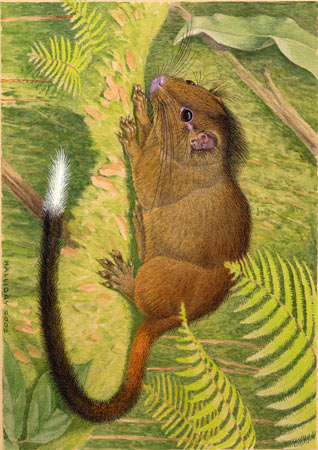New Fat Rat Found in Cloud Forest

If you think rats only dwell in the abysses of smelly subway stations and trashcans, think again. Scientists have spotted a squirrel-sized rodent in the lofty cloud forests of Peru.
The pudgy small mammal is a brand-new species [image]. Observations and preliminary genetic analyses suggest that the rodent's nearest relatives are a group called spiny rats, which are restricted to lowlands. The new rodent's discoverers say this suggests that spiny rats evolved from this Andean species.
The nocturnal, climbing rodent (Isothrix barbarabrownae) has a broad blocky head, bushy tail and a coat of dense, soft fur that is decorated by a black crest on its crown, nape and shoulders.
"Nothing known from those forests bears any resemblance to this thing," said lead scientist Bruce Patterson of the Field Museum in Chicago. "In appearance, it's like a chunky squirrel."
Slick find
Equipped with a headlamp, Patterson spotted the rodent several years ago at about midnight during a survey in Peru's Manu National Park and Biosphere Reserve Mountains, along the eastern slope of the Andes [map].
"[The rodent] was just cooking along the trail, and actually I heard it slip down a moss-encrusted wall. That's when I became aware of it," Patterson told LiveScience.
Get the world’s most fascinating discoveries delivered straight to your inbox.
Along the rat trail at an altitude of 6,200 feet, Patterson snagged the animal, which is now a dead specimen back at his laboratory at the museum.
Mystery fur
The discovery helps to solve a riddle among ecologists: Why would some spiny rats, called bush-tailed tree rats, that reside in the warm, humid lowlands of the Amazon wear such thick coats of fur?
"There's a family called the spiny rats, and it includes [rats] that are so spiny they are like porcupines as well as a few soft-haired members," Patterson said. "Now the soft-haired members had never really made sense--why there would be both spiny and soft-haired members in the lowland forest--until now."
A furry coat makes sense for organisms that live in the cool, damp cloud forests. Patterson suggests the spiny rats first lived in the chilly mountains before they radiated into the lowlands. Some of the rats have not evolved yet to shed their fur for a more weather-appropriate cover.
Most scientists have assumed that since the Andes is such a relatively young mountain chain, its inhabitants must have moved up from lowland areas. Patterson's team will continue to run genetic tests on the specimen in an effort to determine which came first--the mountain rats or the warm-weather ones.
The research is detailed in the current issue of the journal Neotropical Mammalogy.
Jeanna Bryner is managing editor of Scientific American. Previously she was editor in chief of Live Science and, prior to that, an editor at Scholastic's Science World magazine. Bryner has an English degree from Salisbury University, a master's degree in biogeochemistry and environmental sciences from the University of Maryland and a graduate science journalism degree from New York University. She has worked as a biologist in Florida, where she monitored wetlands and did field surveys for endangered species, including the gorgeous Florida Scrub Jay. She also received an ocean sciences journalism fellowship from the Woods Hole Oceanographic Institution. She is a firm believer that science is for everyone and that just about everything can be viewed through the lens of science.
 Live Science Plus
Live Science Plus





